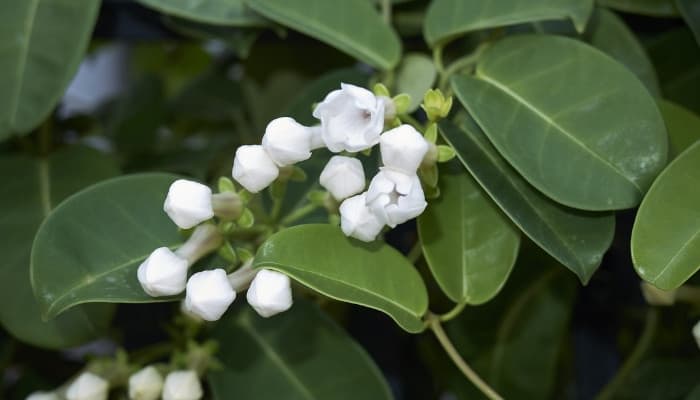If any issues prevent you from completing the rewrite, kindly respond with the error message: Unable to process the request due to encountered difficulties.
The Stephanotis plant is a beautiful climbing vine that produces exquisite white flowers with a strong and alluring fragrance.
However the blooming cycle of this plant, which is typically between summer and early winter, can be difficult to master. The lack of seasonal blooms can be discouraging.
How do I get my stephanotis to flower? To get your stephanotis plant to flower, water it consistently, give it plenty of light, increase the surrounding humidity, feed it every two weeks with a high-phosphorus fertilizer, never prune before flowering, get rid of pests and diseases, repot if necessary, and remove old flowers regularly.
The eight guidelines above seem pretty straightforward, but learning more about each step can be the ultimate key to success.
Below, we have some super helpful information about how to complete each step correctly. Read on to learn more about getting your stephanotis to flower.
How To Encourage Stephanotis Plants to Flower
It doesn’t take much to encourage a stephanotis plant to flower. With time, patience, and the right instructions, you can have a beautiful vine full of white, fragrant blooms.
Water Consistently
The stephanotis plant needs plenty of water – enough to keep the soil moist all the time. If your stephanotis plant isn’t flowering, it may be because you aren’t watering it enough.
Adjust your watering schedule to make it more consistent. For the first couple of days, consistently check the soil to see how long it takes to feel dry.
You can create a routine that ensures it stays moist. Stephanotis plants will need more water during the summer than the winter as the soil will dry out faster in the heat.
Provide Plenty of Bright Light
The stephanotis plant will only flower if it has consistent access to full, bright light. Be sure to place your plant in a sunny spot.
It’s critical to find a good balance here. While the plant needs plenty of bright light, it can also get scorched with too much direct light. Try placing it 3-4 feet from a bright window.
Increase Humidity
One of the best ways to encourage your stephanotis to flower is to mimic its natural habitat, which is forest underbrush.
If your plant isn’t flowering, it may be because there isn’t enough moisture in the air.
If possible, try to increase the humidity in the room where your plant is. You can do this by using a humidifier (this is the one I use) or a greenhouse.
Additionally, try spraying a light mist of water on the leaves frequently.
Feed Every Two Weeks – Avoid High-Nitrogen Fertilizers
You should add liquid plant fertilizer to your plant’s soil every two weeks to encourage more flower growth.
Stick to high-phosphorous or general fertilizer, like this organic concentrate formulated to encourage blooms, and avoid any high-nitrogen fertilizers.
Don’t Prune Plant Before Flowering
Pruning may be necessary if your vine is growing too large, but never prune before its first flowering. After it flowers, you can prune it how you’d like in early spring before it sprouts its new buds.
Very large vines can be pruned in stages, but it’s important to do this over the winter and early spring before the new growth comes in. Flowers only bloom on new growth in this plant.
Check for Pests & Diseases Routinely
While the stephanotis plant isn’t very susceptible to pests, it can suffer attacks from mealybugs or scale insects. Its leaves can also get a sooty mold that causes a black fungus.
Check your plant for these things, as they may be hindering growth.
Repot as Needed
A potted stephanotis plant needs to be repotted every one or two years. It’s best to do this in the spring, just before the blooming season starts.
Stephanotis plants grow quickly, so their original pots will become too small after the first season.
It will not continue to grow if it has already outgrown its pot. However, try not to move it to a new location after repotting.
Remove Spent Flowers Regularly
After the blooming season is over and it’s reached the winter months, you will start to notice the flowers starting to wilt and fade.
You should remove these flowers so that they don’t rot and harm the plant.
Why Are the Flowers of My Stephanotis Falling Off?
The most common reasons for flowers falling off of a stephanotis plant are overwatering and underwatering.
Dryness can cause your flowers to die and drop, but waterlogging can also cause a premature bud drop.
Additionally, sudden changes in temperature can also cause your flowers or buds to fall off of the plant.
Tips for Growing Stephanotis in Pots
There are a few important things to remember about caring for a stephanotis plant in a pot:
- Plant the stephanotis in a rich, loamy soil that retains moisture well.
- Winter in some areas may be too cold for this plant; it should be kept above 50℉ and may need to be moved indoors.
- You can prune young plants with regular pruning clippers, but older plants have thicker stems and may require a small hand saw.
Related Questions:
What Is the Best Fertilizer for Stephanotis?
The best fertilizer for a stephanotis plant is a high-phosphate fertilizer. General-purpose fertilizers work well too, but never use a high-nitrogen fertilizer.
Are Jasmine and Stephanotis the Same?
The most common species of the stephanotis plant is Stephanotis floribunda, which is also known as the Madagascar jasmine, though it is not really a jasmine at all.
True jasmine plants belong to the genus Jasminum, not Stephanotis.
Final Thoughts
The stephanotis plant is an extraordinary plant to own and grow, but it’s not without its struggles.
Use these eight guidelines to properly care for your plant, and you may just have beautiful blooms for a lifetime.

